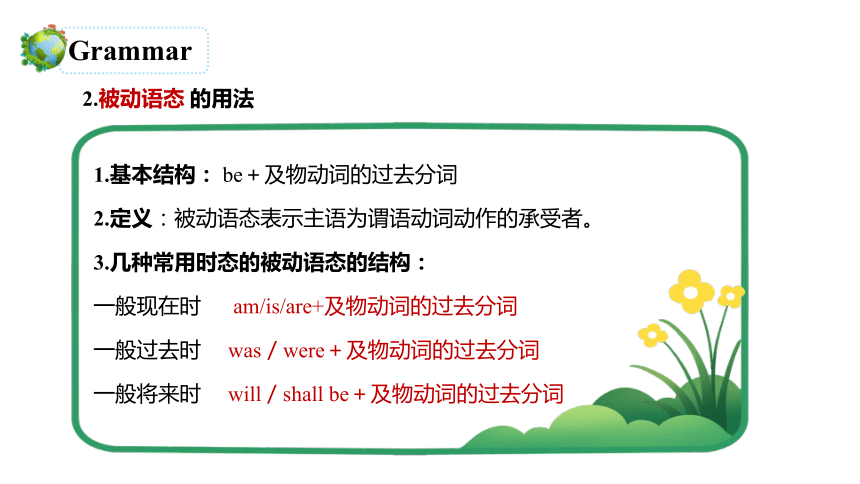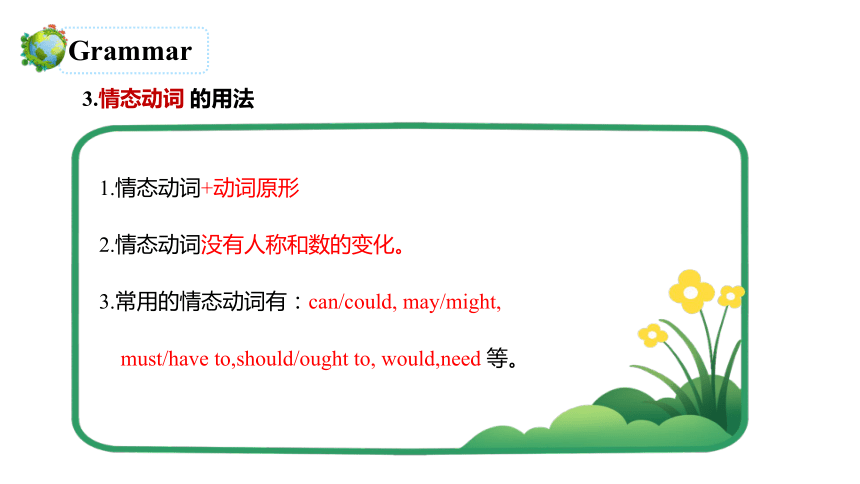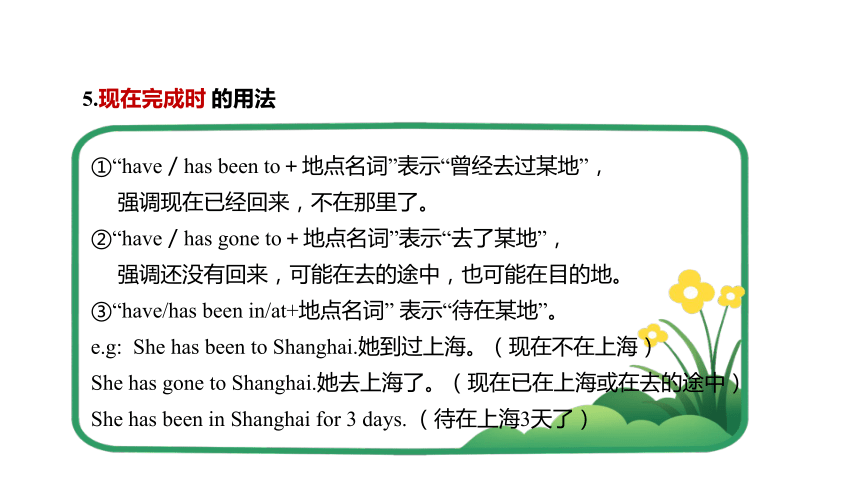九年级全册 unit 13-unit 14 重点语法期末复习课件(共23张PPT)
文档属性
| 名称 | 九年级全册 unit 13-unit 14 重点语法期末复习课件(共23张PPT) |  | |
| 格式 | pptx | ||
| 文件大小 | 22.8MB | ||
| 资源类型 | 教案 | ||
| 版本资源 | 人教新目标(Go for it)版 | ||
| 科目 | 英语 | ||
| 更新时间 | 2024-12-30 16:15:21 | ||
图片预览









文档简介
(共23张PPT)
人教版九年级英语全一册
unit 13-unit 14
重点语法专项复习
unit 13
1.used to 的用法
1.定义:表示过去存在某种状态或者过去经常性、习惯性的动作,
或表示过去存在某种状态。暗含着这种状态或动作目前
已不存在的意思。
2.结构:used to+动词原形;
否定形式为didn't use to do sth.或usedn't to do sth.;
一般疑问形式为Used sb. to do sth. 或Did sb. use to do sth. ;
附加疑问句式为usedn't sb.或didn't sb.。
Grammar
1.基本结构: be+及物动词的过去分词
2.定义:被动语态表示主语为谓语动词动作的承受者。
3.几种常用时态的被动语态的结构:
一般现在时 am/is/are+及物动词的过去分词
一般过去时 was/were+及物动词的过去分词
一般将来时 will/shall be+及物动词的过去分词
2.被动语态 的用法
Grammar
3.情态动词 的用法
1.情态动词+动词原形
2.情态动词没有人称和数的变化。
3.常用的情态动词有:can/could, may/might,
must/have to,should/ought to, would,need 等。
Grammar
1.构成: am/ is/are+动词-ing形式
2.定义:表示现在正在进行或发生的动作,也表示现阶段或当前一段时间内正在进行的动作。
3.常见的标志词或时间状语有:now,look, listen, these days等,有时也需要根据上下文判断。
4.一些表示位置移动的动词,如go,come, leave等常用现在进行时表示将来。
4.现在进行时 的用法
Grammar
1.构成: have/has+动词的过去分词
2.定义:
1)表示过去发生的某一动作对现在造成的影响或结果,
常与already,never,ever,just, before,yet,so far等连用。
2)表示过去已经开始,持续到现在的动作或状态,
常与for+时间段,
since+时间点,
since引导的从句(过去时),
since+一段时间+ago,
how long等时间状语连用。
5.现在完成时 的用法
5.现在完成时 的用法
①“have/has been to+地点名词”表示“曾经去过某地”,
强调现在已经回来,不在那里了。
②“have/has gone to+地点名词”表示“去了某地”,
强调还没有回来,可能在去的途中,也可能在目的地。
③“have/has been in/at+地点名词” 表示“待在某地”。
e.g: She has been to Shanghai.她到过上海。(现在不在上海)
She has gone to Shanghai.她去上海了。(现在已在上海或在去的途中)
She has been in Shanghai for 3 days. (待在上海3天了)
Exercises
1. He _____ go out with his parents, but now he _____ staying at home alone.
A. used to; is used to B. is used to; used to
C. used to; used to D. is used to; is used to
2.He promised to pick me up at the school gate.However, he _____ yet.
A. didn’t arrive B. doesn’t arrive
C. isn’t arriving D. hasn’t arrived
3. Ba Jin, one of the greatest writers in China, ___ as “People’s Writer”.
A. is regarded B. has regarded
C. is regarding D. regards
4.—At present, one of the best ways to study is working in groups.
—More chances ______ to students to learn from each other.
A. offer B. are offered
C. have offered D. are offering
Exercises
5. Look! The police ______ the food onto the bank of the river.
A. am carrying B. is carrying
C. are carrying D. are carried
6.— Mr. Li will check our homework this afternoon. ______ you ______ it
— Not yet. I’m doing it right now.
A. Do; finish B. Had; finished
C. Will; finish D. Have; finished
7.Children under 12 years old_________ ride sharing bikes. It's too dangerous.
A. shouldn't allow to B. shouldn't allow
C. shouldn't be allowed to D. shouldn't be allowed
(1)用法
a.表经常发生的事情、存在的动作或状态
b.表内心活动感情等
c.描述客观真理
d.表按计划的,预定的行为
(2)结构
主语 + be (am, is, are)
主语 + 动词原形/动词第三人称单数
(3)标志词
every day, often, sometimes, usually, always, twice a week…
一般
现在时
一般现在时
unit 14
I don't think you are right.
Birds fly in the sky.
(1)用法
a.表示过去某个时间或一段时间内
发生的动作或存在的状态。
b. 表示过去经常或反复发生的动作。
(2)结构
主语 + be (was, were)
主语 + 过去式
(3)标志词
yesterday, just now, last year, in the past,…ago等
一般
过去时
一般过去时
Grammar Focus
I was very fat in my childhood.
I bought the Huawei P50 Pro last week.
(1)用法
a. 表示此时此刻正在进行的动作
b. 表示现阶段正在进行的动作或持续的状态
(2)结构
主语 + am/is/are +v-ing
(3)标志词
right now, at this moment, now等
现在
进行时
Grammar Focus
Jill is running out of breath to catch a bus.
Listen! The birds are singing in the trees outside our school.
现在进行时
(1)用法
a.表示截止目前已完成的动作
b.表示发生在过去而对现在产生影响、带来结果的动作
c.表示过去发生的动作持续到现在,并可能还要延续下去
(2)结构
have/has +done
(3)标志词
for + 时间段 / since + 过去时间点(从句)
already / yet / ever / never / just / recently / lately /so far
现在
完成时
Grammar Focus
She has been to the United States.
I have learned English for 8 years.
现在完成时
在现在完成时态中,
和表示一段时间的状语(for, since, how long)连用的动词必须是延续性动词。
(1)用法
a.要在将来的某个时间内发生,是“纯粹的将来动作”。
b.表说话人的意图、打算或某种可能性
(2)结构
will + 动词原形
be going to + 动词原形
(3)标志词
tomorrow, in the future, in two days,next year, this weekend等
一般
将来时
一般将来时
Grammar Focus
Next week, each student will receive a small gift from teachers.
Who is going to speak first
NOW
TIME
1.will + 动词原形
2.be going to + 动词原形
主语 + have / has + done
1.主语 + be (was, were)
2.主语 + 过去式
一般过去时
现在完成时
一般将来时
1.主语 + be (am, is, are)
2.主语 + 动词原形/单三
一般现在时
Grammar rules
Grammar Focus
宾语从句
Grammar Focus
引导词
语序
时态
宾语从句
三要素
I know that your love is gone.
I believe (that) I can fly.
I don't care if you do.
I'm gonna wear it whether you like it or not.
I don't care who you are, where you are from...
陈述语序
that
疑问词
if/
whether
宾语从句
引导词
当宾语从句是_______句时,由_____引导。无词义,可省略。
当宾语从句是 __________时 , 由 连词_______________引导。
表示_______的意思。
陈述句
that
whether或if
一般疑问句
是否
当宾语从句是 __________时 , 由__________________ 引导。
原句的特殊疑问词
特殊疑问句
Grammar Focus
宾语从句
主句是_______________,
宾语从句可以是_________________。
当从句是客观真理/定义/公理/定理时,从句只能用______________
宾语从句
时态
主句是_________________________,
宾语从句可以是________________。
一般现在时/或一般将来时
任意时态
一般过去时
相应的过去时态
一般现在时
主现从任意
主过从必过
真理永一现
Grammar Focus
宾语从句
引导词
语序
特殊疑问词引导的
宾语从句
who, whom, whose, which, what,等
疑问代词
疑问副词
when,where,why,how等
宾语从句为特殊疑问句时,当从句的主语
与主句的主语或间接宾语__________(一致/不一致)时,
宾语从句可简化为____________________________形式.
一致
“特殊疑问词+动词不定式”
无论主句是陈述句还是疑问句,也无论主从句是什么引导词,宾语从句一律用__________,即“__________________________”。
陈述语序
引导词+主语+谓语+其它
Grammar Focus
宾语从句
Can you tell me how I can get to the train station
=Can you tell me how to get to the train station
—The 2022 Winter Olympics was held in China.
Do you know which cities it was held in
—Yes. In Beijing and Zhangjiakou.
—I’ve found a new pen, but I don’t know whose it is.
—It must be Lucy’s. She is looking for her pen.
Grammar Focus
宾语从句
时态 定义
一般现在时
一般过去时
一般将来时
经常、反复发生的动作或行为及状况。
过去某个时间里发生的动作或存在的状态。
时态复习
现在完成时
将要发生的动作或存在的状态及打算、计划或准备做某事。
过去发生的动作对现在造成的影响或过去的动作或状态持续到现在。
时态 构成
一般现在时
一般过去时
一般将来时
主语+ 动词原形
主语+was/ were+其他.
主语+实义动词的过去式+其他
be(is, am, are) going to do;
will/shall do
现在完成时
Have/has + done +其他
时态 标志词
一般现在时
一般过去时
一般将来时
always, usually, often, sometimes,
every week (day, year, month...)
yesterday, last week, two months ago, the day before yesterday...
tomorrow, next day (week, month,
year), the day after tomorrow...
现在完成时
since, ever, up to now, so far, just, already, yet, for the past few years…
人教版九年级英语全一册
unit 13-unit 14
重点语法专项复习
unit 13
1.used to 的用法
1.定义:表示过去存在某种状态或者过去经常性、习惯性的动作,
或表示过去存在某种状态。暗含着这种状态或动作目前
已不存在的意思。
2.结构:used to+动词原形;
否定形式为didn't use to do sth.或usedn't to do sth.;
一般疑问形式为Used sb. to do sth. 或Did sb. use to do sth. ;
附加疑问句式为usedn't sb.或didn't sb.。
Grammar
1.基本结构: be+及物动词的过去分词
2.定义:被动语态表示主语为谓语动词动作的承受者。
3.几种常用时态的被动语态的结构:
一般现在时 am/is/are+及物动词的过去分词
一般过去时 was/were+及物动词的过去分词
一般将来时 will/shall be+及物动词的过去分词
2.被动语态 的用法
Grammar
3.情态动词 的用法
1.情态动词+动词原形
2.情态动词没有人称和数的变化。
3.常用的情态动词有:can/could, may/might,
must/have to,should/ought to, would,need 等。
Grammar
1.构成: am/ is/are+动词-ing形式
2.定义:表示现在正在进行或发生的动作,也表示现阶段或当前一段时间内正在进行的动作。
3.常见的标志词或时间状语有:now,look, listen, these days等,有时也需要根据上下文判断。
4.一些表示位置移动的动词,如go,come, leave等常用现在进行时表示将来。
4.现在进行时 的用法
Grammar
1.构成: have/has+动词的过去分词
2.定义:
1)表示过去发生的某一动作对现在造成的影响或结果,
常与already,never,ever,just, before,yet,so far等连用。
2)表示过去已经开始,持续到现在的动作或状态,
常与for+时间段,
since+时间点,
since引导的从句(过去时),
since+一段时间+ago,
how long等时间状语连用。
5.现在完成时 的用法
5.现在完成时 的用法
①“have/has been to+地点名词”表示“曾经去过某地”,
强调现在已经回来,不在那里了。
②“have/has gone to+地点名词”表示“去了某地”,
强调还没有回来,可能在去的途中,也可能在目的地。
③“have/has been in/at+地点名词” 表示“待在某地”。
e.g: She has been to Shanghai.她到过上海。(现在不在上海)
She has gone to Shanghai.她去上海了。(现在已在上海或在去的途中)
She has been in Shanghai for 3 days. (待在上海3天了)
Exercises
1. He _____ go out with his parents, but now he _____ staying at home alone.
A. used to; is used to B. is used to; used to
C. used to; used to D. is used to; is used to
2.He promised to pick me up at the school gate.However, he _____ yet.
A. didn’t arrive B. doesn’t arrive
C. isn’t arriving D. hasn’t arrived
3. Ba Jin, one of the greatest writers in China, ___ as “People’s Writer”.
A. is regarded B. has regarded
C. is regarding D. regards
4.—At present, one of the best ways to study is working in groups.
—More chances ______ to students to learn from each other.
A. offer B. are offered
C. have offered D. are offering
Exercises
5. Look! The police ______ the food onto the bank of the river.
A. am carrying B. is carrying
C. are carrying D. are carried
6.— Mr. Li will check our homework this afternoon. ______ you ______ it
— Not yet. I’m doing it right now.
A. Do; finish B. Had; finished
C. Will; finish D. Have; finished
7.Children under 12 years old_________ ride sharing bikes. It's too dangerous.
A. shouldn't allow to B. shouldn't allow
C. shouldn't be allowed to D. shouldn't be allowed
(1)用法
a.表经常发生的事情、存在的动作或状态
b.表内心活动感情等
c.描述客观真理
d.表按计划的,预定的行为
(2)结构
主语 + be (am, is, are)
主语 + 动词原形/动词第三人称单数
(3)标志词
every day, often, sometimes, usually, always, twice a week…
一般
现在时
一般现在时
unit 14
I don't think you are right.
Birds fly in the sky.
(1)用法
a.表示过去某个时间或一段时间内
发生的动作或存在的状态。
b. 表示过去经常或反复发生的动作。
(2)结构
主语 + be (was, were)
主语 + 过去式
(3)标志词
yesterday, just now, last year, in the past,…ago等
一般
过去时
一般过去时
Grammar Focus
I was very fat in my childhood.
I bought the Huawei P50 Pro last week.
(1)用法
a. 表示此时此刻正在进行的动作
b. 表示现阶段正在进行的动作或持续的状态
(2)结构
主语 + am/is/are +v-ing
(3)标志词
right now, at this moment, now等
现在
进行时
Grammar Focus
Jill is running out of breath to catch a bus.
Listen! The birds are singing in the trees outside our school.
现在进行时
(1)用法
a.表示截止目前已完成的动作
b.表示发生在过去而对现在产生影响、带来结果的动作
c.表示过去发生的动作持续到现在,并可能还要延续下去
(2)结构
have/has +done
(3)标志词
for + 时间段 / since + 过去时间点(从句)
already / yet / ever / never / just / recently / lately /so far
现在
完成时
Grammar Focus
She has been to the United States.
I have learned English for 8 years.
现在完成时
在现在完成时态中,
和表示一段时间的状语(for, since, how long)连用的动词必须是延续性动词。
(1)用法
a.要在将来的某个时间内发生,是“纯粹的将来动作”。
b.表说话人的意图、打算或某种可能性
(2)结构
will + 动词原形
be going to + 动词原形
(3)标志词
tomorrow, in the future, in two days,next year, this weekend等
一般
将来时
一般将来时
Grammar Focus
Next week, each student will receive a small gift from teachers.
Who is going to speak first
NOW
TIME
1.will + 动词原形
2.be going to + 动词原形
主语 + have / has + done
1.主语 + be (was, were)
2.主语 + 过去式
一般过去时
现在完成时
一般将来时
1.主语 + be (am, is, are)
2.主语 + 动词原形/单三
一般现在时
Grammar rules
Grammar Focus
宾语从句
Grammar Focus
引导词
语序
时态
宾语从句
三要素
I know that your love is gone.
I believe (that) I can fly.
I don't care if you do.
I'm gonna wear it whether you like it or not.
I don't care who you are, where you are from...
陈述语序
that
疑问词
if/
whether
宾语从句
引导词
当宾语从句是_______句时,由_____引导。无词义,可省略。
当宾语从句是 __________时 , 由 连词_______________引导。
表示_______的意思。
陈述句
that
whether或if
一般疑问句
是否
当宾语从句是 __________时 , 由__________________ 引导。
原句的特殊疑问词
特殊疑问句
Grammar Focus
宾语从句
主句是_______________,
宾语从句可以是_________________。
当从句是客观真理/定义/公理/定理时,从句只能用______________
宾语从句
时态
主句是_________________________,
宾语从句可以是________________。
一般现在时/或一般将来时
任意时态
一般过去时
相应的过去时态
一般现在时
主现从任意
主过从必过
真理永一现
Grammar Focus
宾语从句
引导词
语序
特殊疑问词引导的
宾语从句
who, whom, whose, which, what,等
疑问代词
疑问副词
when,where,why,how等
宾语从句为特殊疑问句时,当从句的主语
与主句的主语或间接宾语__________(一致/不一致)时,
宾语从句可简化为____________________________形式.
一致
“特殊疑问词+动词不定式”
无论主句是陈述句还是疑问句,也无论主从句是什么引导词,宾语从句一律用__________,即“__________________________”。
陈述语序
引导词+主语+谓语+其它
Grammar Focus
宾语从句
Can you tell me how I can get to the train station
=Can you tell me how to get to the train station
—The 2022 Winter Olympics was held in China.
Do you know which cities it was held in
—Yes. In Beijing and Zhangjiakou.
—I’ve found a new pen, but I don’t know whose it is.
—It must be Lucy’s. She is looking for her pen.
Grammar Focus
宾语从句
时态 定义
一般现在时
一般过去时
一般将来时
经常、反复发生的动作或行为及状况。
过去某个时间里发生的动作或存在的状态。
时态复习
现在完成时
将要发生的动作或存在的状态及打算、计划或准备做某事。
过去发生的动作对现在造成的影响或过去的动作或状态持续到现在。
时态 构成
一般现在时
一般过去时
一般将来时
主语+ 动词原形
主语+was/ were+其他.
主语+实义动词的过去式+其他
be(is, am, are) going to do;
will/shall do
现在完成时
Have/has + done +其他
时态 标志词
一般现在时
一般过去时
一般将来时
always, usually, often, sometimes,
every week (day, year, month...)
yesterday, last week, two months ago, the day before yesterday...
tomorrow, next day (week, month,
year), the day after tomorrow...
现在完成时
since, ever, up to now, so far, just, already, yet, for the past few years…
同课章节目录
- Unit 1 How can we become good learners.
- Section A
- Section B
- Unit 2 I think that mooncakes are delicious!
- Section A
- Section B
- Unit 3 Could you please tell me where the restroom
- Section A
- Section B
- Unit 4 I used to be afraid of the dark.
- Section A
- Section B
- Unit 5 What are the shirts made of?
- Section A
- Section B
- Review of Units 1-5
- Unit 6 When was it invented?
- Section A
- Section B
- Unit 7 Teenagers should be allowed to choose their
- Section A
- Section B
- Unit 8 It must belong to Carla.
- Section A
- Section B
- Unit 9 I like music that I can dance to.
- Section A
- Section B
- Unit 10 You're supposed to shake hands.
- Section A
- Section B
- Review of Units 6-10
- Unit 11 Sad movies make me cry.
- Section A
- Section B
- Unit 12 Life is full of the unexpected
- Section A
- Section B
- Unit 13 We're trying to save the earth!
- Section A
- Section B
- Unit 14 I remember meeting all of you in Grade 7.
- Section A
- Section B
- Review of Units 11-14
